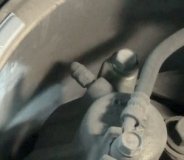In the previous thread, it was explained to me that the purpose of having two different size brake lines is to increase the braking force at the caliper.
What would be the downside if the brake line is replaced with just one size, instead of two different size brake lines like the OEM?
The brake line that I need to replace is for the rear passenger side. The attached YouTube video illustrates the process. In that video, if you pause it at min 1:20, you will notice that about 2" of the bent brake line that gets screwed into the rubber brake hose is a bit thinner than the rest of the brake line. That very short, thinner section is probably 3/16" and the rest is probably 1/4". When they replaced the new brake line, the entire line was the same tube size, which appears to be 1/4". From what was explained to me, a special type of machine is required to replicate a brake line exactly as the OEM on that car, since that same brake line has two different tube sizes. So, as an alternative option, is it perfectly okay to do it the same way they did it, which is to disregard the two different tube sizes and just stick to one tube size? Also, is there any downside or safety concerns to doing it that way?
Furthermore, the tube nut (fitting) that would fit onto a 3/16" brake line would be a different size than the one that would fit onto a 1/4" brake line. So, how in the world were they able to fit in a tube nut that's suitable for a 1/4" brake line into the rubber brake hose? The fitting for that rubber brake hose is M10x1.0, which is the size that's suitable for a 3/16" brake line. I'm actually very confused.
I'm looking into purchasing a pre-flared brake line. There are domestic, Japanese, and European brake lines. I understand that the European brake lines are bubble flared. However, what is the difference between domestic and Japanese brake lines that are both double flared?
Furthermore, as an example, if we take a look at the attached Part # CNJ-312, which is a pre-flared Japanese brake line, both fittings are the same size. On the other hand, the attached Part # CN-312, which is a pre-flared domestic brake line, why does it have one fitting that is longer than the other one?
Thank you!
Cheers!
https://youtu.be/Zj3HfNOZsxI
Images (Click to make bigger)
Monday, October 18th, 2021 AT 3:08 PM











